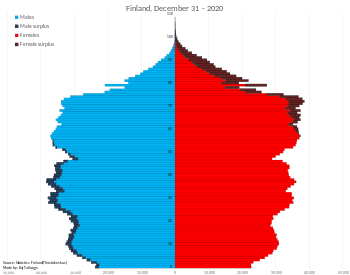
Back التركيبة السكانية في فنلندا Arabic Насельніцтва Фінляндыі BE Население на Финландия Bulgarian Obyvatelstvo Finska Czech Demografía de Finlandia Spanish Finlandiako demografia EU Suomen väestö Finnish Démographie de la Finlande French Demografía de Finlandia GL Finnország demográfiája Hungarian
| Demographics of Finland | |
|---|---|
 Population pyramid of Finland in 2020 | |
| Population | 5,637,214 |
| Growth rate | 0.7 (2023)[1] |
| Birth rate | 7.8 births/1,000 population (2023 est.) |
| Death rate | 10.9 deaths/1,000 population (2023 est.) |
| Life expectancy | 81.76 years |
| • male | 78.86 years |
| • female | 84.79 years (2023) |
| Fertility rate | 1.26 children born/woman (2023 est.)[2] |
| Infant mortality rate | 2.13 deaths/1,000 live births |
| Net migration rate | 10.47 migrant(s)/1,000 population (2023 est.) |
| Age structure | |
| 0–14 years | 14.9% (2023)[1] |
| 15–64 years | 61.8% (2023)[1] |
| 65 and over | 23.4% (2023)[1] |
| Sex ratio | |
| Total | 0.97 male(s)/female (2023) |
| At birth | 1.05 male(s)/female |
| Under 15 | 1.05 male(s)/female |
| 65 and over | 0.63 male(s)/female |
| Nationality | |
| Nationality | Finn |
| Major ethnic | Finnish (89.8% background)[1] |
| Language | |
| Official | Finnish, Swedish |
| Spoken | Finnish, Swedish, Sámi |
The demographics of Finland is monitored by the Statistics Finland (Finnish: Tilastokeskus, Swedish: Statistikcentralen). Finland has a population of over 5.6 million people, ranking it 19th out of 27 within the European Union. The average population density in Finland is 19 inhabitants per square kilometre (49/sq mi), making it the third most sparsely populated country in Europe, after Iceland and Norway. Population distribution is extremely uneven, with the majority of the population concentrated in the southern and western regions of the country. The majority of the Finnish population - approximately 73% - lives in urban areas. Approximately 1.61 million, or almost 30%, reside solely in the Helsinki Metropolitan Area. Conversely, the Arctic Lapland region contains only two inhabitants per square kilometre (5.2/sq mi).[3]
Until recently, Finland has been mainly an ethnically homogeneous country, with native Finns being the dominant ethnic group. However, with increased immigration, the country is slowly becoming more ethnically diverse. In addition, Finland is home to significant groups of Finno-Swedish, Sámi and Roma minorities, which have long historical roots in the country. The official languages are Finnish and Swedish, of which 84.9 percent and 5.1 percent of the population respectively speak as their mother tongue.[1] Finland was a part of the Swedish kingdom for around 500 years.[4]
Due to recent immigration, significant populations of ethnic Estonians, Russians, Iraqis, Chinese, Somalis, Kurds and Indians now reside in the country. Furthermore, by 2023, Ukrainians had become one of the largest ethnic group in the region.[1]
As of 2023[update], Statistics Finland publishes data on the foreign population using three distinct methodologies. The Finnish population includes persons of foreign origin and background, who make up 10.2% of the total population.[note 1] In additional calculations, the proportion of persons born outside Finland is 9.6%. Individuals who have a first language other than Finnish, Swedish or Sámi account for 10.0%.[1]
In the history of Finland, the first human settlement originated approximately 11,000 BC, following the end of the Ice Age.[6] The initial settlers of present-day Finland were presumably hunter-gatherers. They were later replaced by the Sámi, followed by Finnic populations from the east, south and west. The initial dependable population information dates back to 1749 when Swedish officials initially recorded population statistics. Finland was a part of the Swedish Kingdom until it became a Grand Duchy ruled by the Russian Empire in 1809, and finally gained its full independence in 1917.
In the late 19th and 20th centuries, significant emigration, primarily from rural areas, occurred to Sweden and North America, while Finland's primary immigrant source was other European countries. Approximately 300,000 Finnish nationals reside abroad and, according to estimates, the number of individuals of Finnish ancestry worldwide ranges from 1.6 to 2 million. Currently, Sweden, the United Kingdom, Germany, the United States, and Spain are the preferred destinations for most Finnish emigrants.[7]
One of the primary challenges facing society in the future is adapting to demographic changes, particularly the aging of the population. The proportion of the working-age population is decreasing, resulting in projected labour shortages.[8] However, immigration has significantly increased in recent years. If the current trend persists, the population of Finland will continue to increase and could even reach the milestone of 6 million people by 2040.[9]
- ^ a b c d e f g h "Population growth biggest in nearly 70 years". Population structure. Statistics Finland. 26 April 2024. ISSN 1797-5395. Retrieved 29 April 2024.
- ^ "Immigration record high in Finland in 2023". Statistics Finland. 25 January 2024. Retrieved 25 January 2024.
- ^ "Population structure 2000-2022, urban-rural classification". Statistics Finland. 26 May 2023. Retrieved 29 September 2023.
- ^ "Number of foreign-language speakers grew by nearly 38,000 persons". Statistics Finland. 31 May 2023. Retrieved 12 September 2023.
- ^ "Persons with foreign background". Statistics Finland. Archived from the original on 5 January 2021. Retrieved 18 September 2023.
- ^ Cite error: The named reference
hs-ensimmaisilla-suomalaisillawas invoked but never defined (see the help page). - ^ "Expatriate Finns are united by their Finnish identity". Ministry of the Interior. Retrieved 29 September 2023.
- ^ Cite error: The named reference
eurydice-population-finlandwas invoked but never defined (see the help page). - ^ "Kuusi miljoonaa suomalaista vuonna 2040 – totta vai tarua?" (in Finnish). Satakunnan kansa. 20 September 2023. Retrieved 2 October 2023.
Cite error: There are <ref group=note> tags on this page, but the references will not show without a {{reflist|group=note}} template (see the help page).